Feel Like You’re On Another Planet at Craters of the Moon National Monument in Southern Idaho
This article originally appeared on My Yellowstone Park
A 52-mile long tear in the Earth's crust called the "Great Rift" caused a ton of volcanic eruptions in this part of southern Idaho starting 15,000 years ago. Today, Craters of the Moon National Monument is filled with lava flows, cinder and spatter cones and caves.
When declaring the area a national monument, President Coolidge dubbed it a "weird and scenic landscape." On a visit to this special spot, you'll understand why.
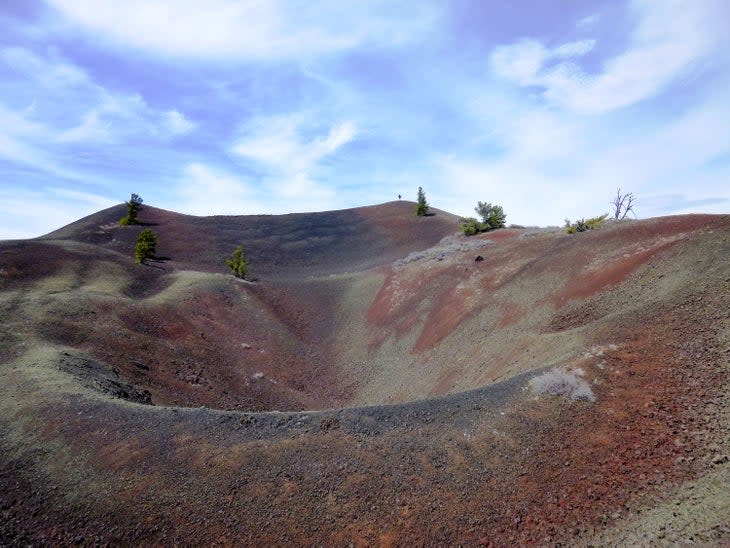
What is Special About Craters of the Moon?
While any volcanic landscape is unique and fascinating, Craters of the Moon is special because it's a relatively young one. The last eruption in this area occurred approximately 2,000 years ago. While that may seem like an incredibly long time, it's considered recent as far as geology is concerned. The Shoshone people were around to witness the eruption which puts the timeline into perspective.
Craters of the Moon is home to other-worldly hiking trails, cool caves, plants and wildlife with unique adaptations, and some of the darkest night skies in the world.
Things to Do at Craters of the Moon
Peer into a Spatter Cone
These "mini volcanoes" are fascinating and easy to look inside thanks to trails leading to their tops. At the end of a volcanic eruption, these cones were formed when hot lava was tossed into the air and fell back down to earth around a small vent. The short walk up the Spatter Cones Trail or the Snow Cone Trail will allow you to check out the view inside. If you or someone you're traveling with has limited mobility, head to the Snow Cone Trail which is wheelchair accessible.
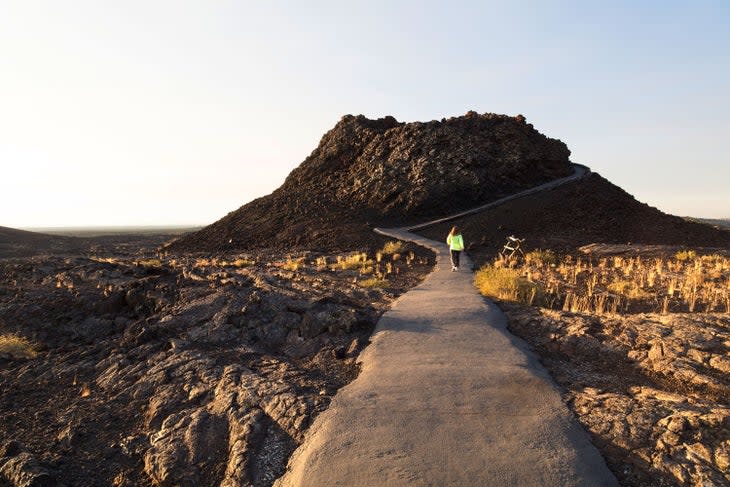
Walk Through a Cave
There are many lava tube caves at Craters of the Moon and two of them are open for visitors to explore. The others are closed to protect bat populations. Hike the 1.6-mile round-trip Caves Trail which will bring you to Indian Cave and Dewdrop Cave. Indian Cave is 800 feet long and has stairs at the entrance to get down into it. Dewdrop Cave is a bit more challenging, but still doable for most hikers. Be sure to carry a flashlight or headlamp as the caves are dark, even during the day.
A free cave permit is required to explore these spots to help protect bats. Pick one up at the visitor center during business hours. This allows rangers to screen you to ensure you aren't potentially spreading white-nose syndrome, which is deadly to bats.
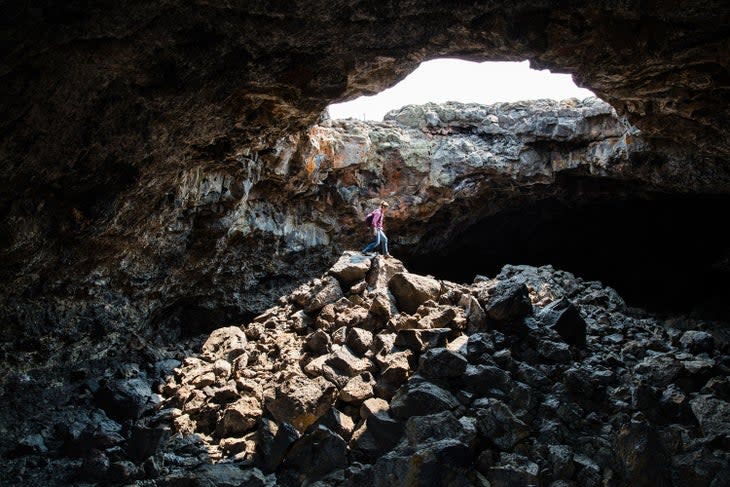
Go for a Hike
For a short but steep hike, take the trail to the top of Inferno Cone for gorgeous views. You may even be able to see the Tetons on a clear day. It's 0.4 miles roundtrip. For a longer hike that showcases everything the monument has to offer, take the 1.8-mile Broken Top Loop. You can also access the Wilderness Trail from this loop which will bring you into the less-traveled Wilderness Area, the first of its kind in a national park. The Wilderness Trail is 8 miles roundtrip from the parking lot.
Other great trails in the monument include the 2-mile round-trip Tree Molds Trail where you'll see impressions left by ancient trees in the lava, or the 3.5-mile round-trip North Crater Trail. This hike gains 758 feet of elevation as it climbs to the lip of, and drops into, the North Crater.
As you hike, keep a lookout for some of the species that aren't found anywhere else in the world like the unique subspecies of pika and yellow-bellied marmots as well as the lava tube cave beetles. You might also spot pronghorn, coyotes and other prairie animals.
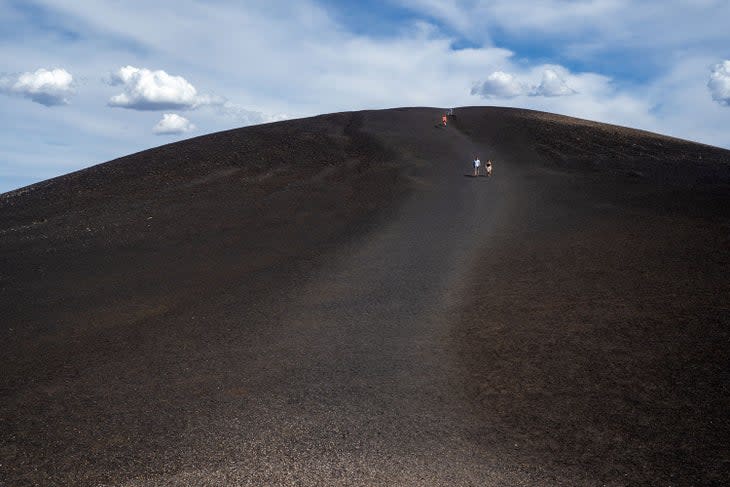
Is Craters of the Moon Free?
Craters of the Moon National Monument is not free. It costs $20 for a 7-day pass, which covers all people riding in your vehicle with you. You can pay by credit card at the automated entrance station fee machines, or with cash through the visitor center.
If you have an interagency pass such as the Interagency Annual Pass or the Interagency Senior Pass, you can use it to enter Craters of the Moon.
Can you drive through Craters of the Moon?
The 7-mile Loop Road is where most of the park’s attractions are located making it easy to take a scenic drive through the monument and see a lot from the comfort of your car. If you don't have the time or ability to get out of your car and go for a hike, you can still see plenty of interesting formations and the surrounding landscape out the window.
The Loop Road closes in the winter months, usually late November through April or May.
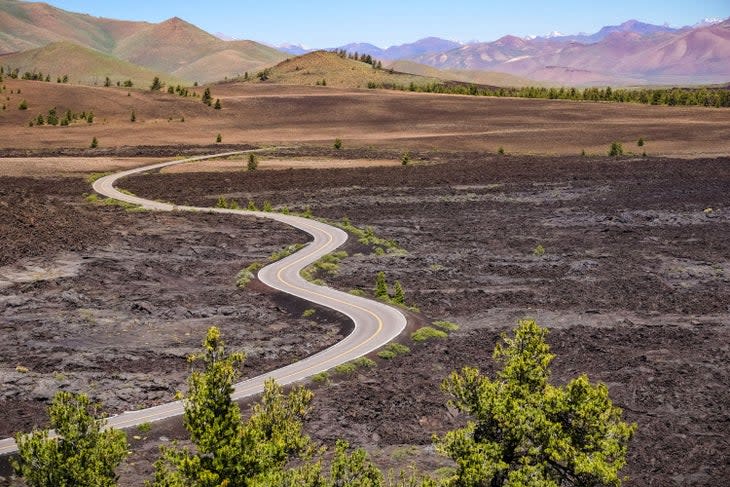
How Much Time Should You Spend at Craters of the Moon?
There's easily enough to do at Craters of the Moon to spend the whole day exploring, but you can also get an adequate sense of the area and have fun exploring for a few hours or less. This monument makes for a great road trip stop (check out our Salt Lake City to Yellowstone Road Trip for a great option) since lots of the most interesting formations are located along the Loop Road which is a quick and easy drive.
Where to Stay
The Lava Flow Campground is the only place to stay in Craters of the Moon National Monument. It's open seasonally when the Loop Road is open, usually April or May to late November. There are no hookups at the campground, but there is seasonal potable water and restrooms with flush toilets. The first 15 sites can accommodate RVs, some up to 100 feet in length, while the remaining 27 are best left to tents. All sites are first-come, first-served and cost $15 per night.
There is no lodging or food available in the park. The nearest town with both is Arco, Idaho, approximately 18 miles east. Twin Falls and Idaho Falls are also nearby and larger, at approximately a 1.5 hour drive.
For exclusive access to all of our fitness, gear, adventure, and travel stories, plus discounts on trips, events, and gear, sign up for Outside+ today.

